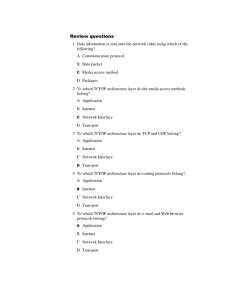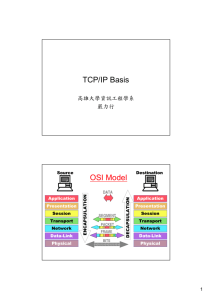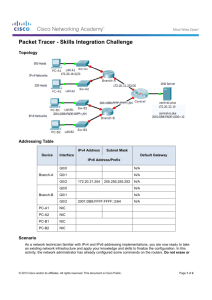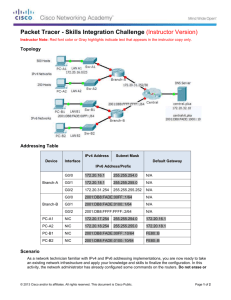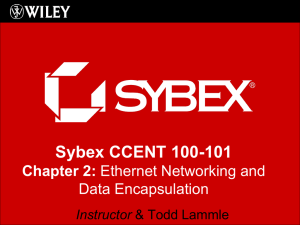Módulo: Mecanizado (MEC)
advertisement
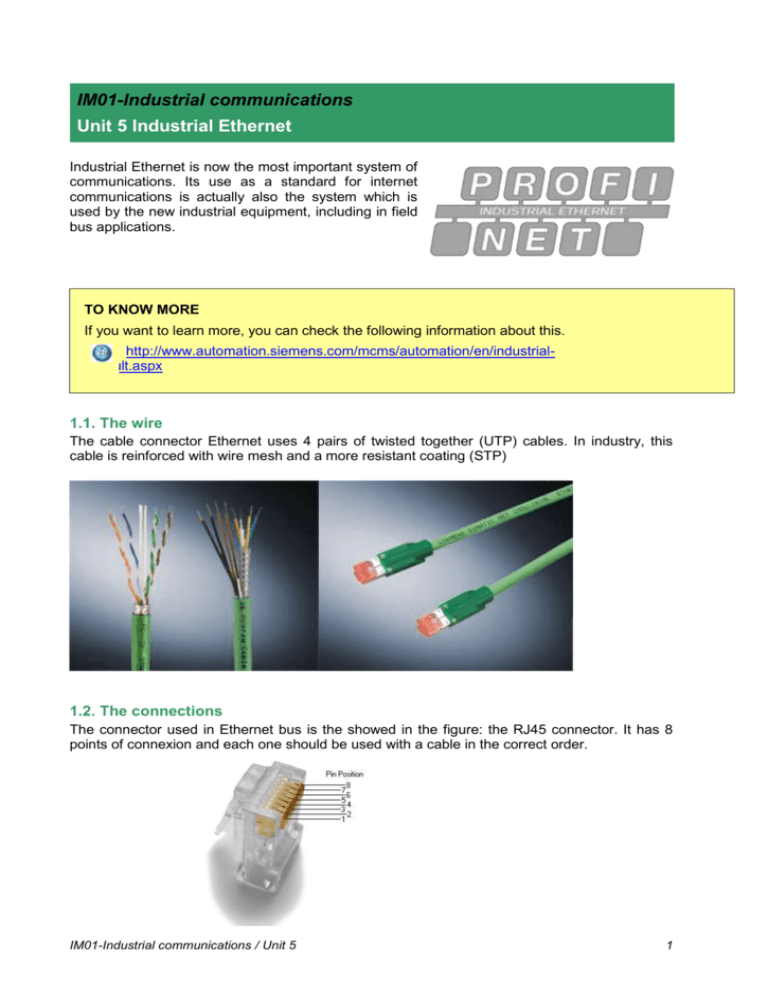
IM01-Industrial communications Unit 5 Industrial Ethernet Industrial Ethernet is now the most important system of communications. Its use as a standard for internet communications is actually also the system which is used by the new industrial equipment, including in field bus applications. TO KNOW MORE If you want to learn more, you can check the following information about this. http://www.automation.siemens.com/mcms/automation/en/industrialrofibus/pages/default.aspx 1.1. The wire The cable connector Ethernet uses 4 pairs of twisted together (UTP) cables. In industry, this cable is reinforced with wire mesh and a more resistant coating (STP) 1.2. The connections The connector used in Ethernet bus is the showed in the figure: the RJ45 connector. It has 8 points of connexion and each one should be used with a cable in the correct order. IM01-Industrial communications / Unit 5 1 We need a special tool for the connection of the RJ-45 with the cable: the crimper. The distribution of the Ethernet net is always in star. The hub is the most basic device connection. It is used in local networks with a limited number of machines. It is more than a multiple RJ45 jack that amplifies the signal from the network (base 10/100). IM01-Industrial communications / Unit 5 2 1.3. Ethernet (Internet) protocol The Internet protocol family is a set of network protocols on which the Internet is based and which allows the transmission of data between computer networks. It is sometimes called the TCP / IP protocols, referring to the two most important protocols that compose it: the Transmission Control Protocol (TCP) and Internet Protocol (IP). An Internet Protocol address (IP address) is a numerical label assigned to each device (e.g., computer, printer) participating in a computer network that uses the Internet Protocol for communication. An IP address serves two principal functions: host or network interface identification and location addressing. Its role has been characterized as follows: "A name indicates what we seek. An address indicates where it is. A route indicates how to get there." The designers of the Internet Protocol defined an IP address as a 32-bit number consisting of 4 octets and this system, known as Internet Protocol Version 4 (IPv4), is still in use today. However, due to the enormous growth of the Internet and the predicted depletion of available addresses, a new version of IP (IPv6), using 128 bits for the address, was developed in 1995. IPv6 was standardized as RFC 2460 in 1998, and its deployment has been ongoing since the mid-2000s. IP addresses are binary numbers, but they are usually stored in text files and displayed in human-readable notations, such as 172.16.254.1 (for IPv4), and 2001:db8:0:1234:0:567:8:1 (for IPv6). The Internet Assigned Numbers Authority (IANA) manages the IP address space allocations globally and delegates five regional Internet registries (RIRs) to allocate IP address blocks to local Internet registries (Internet service providers) and other entities. IP subnetworks. IP networks may be divided into subnetworks in both IPv4 and IPv6. For this purpose, an IP address is logically recognized as consisting of two parts: the network prefix and the host identifier, or interface identifier (IPv6). The subnet mask or the CIDR prefix determines how the IP address is divided into network and host parts. The term subnet mask is only used within IPv4. Both IP versions however use the CIDR concept and notation. In this, the IP address is followed by a slash and the number (in decimal) of bits IM01-Industrial communications / Unit 5 3 used for the network part, also called the routing prefix. For example, an IPv4 address and its subnet mask may be 192.0.2.1 and 255.255.255.0, respectively. The CIDR notation for the same IP address and subnet is 192.0.2.1/24, because the first 24 bits of the IP address indicates the network and subnet. IP address assignment Internet Protocol addresses are assigned to host either a new at the time of booting, or permanently by fixed configuration of its hardware or software. Persistent configuration is also known as using a static IP address. In contrast, in situations when the computer's IP address is assigned newly each time, this is known as using a dynamic IP address. Methods Static IP addresses are manually assigned to a computer by an administrator. The exact procedure varies according to platform. This contrasts with dynamic IP addresses, which are assigned either by the computer interface or host software itself, as in Zero conf, or assigned by a server using Dynamic Host Configuration Protocol (DHCP). Even though IP addresses assigned using DHCP may stay the same for long periods of time, they can generally change. In some cases, a network administrator may implement dynamically assigned static IP addresses. In this case, a DHCP server is used, but it is specifically configured to always assign the same IP address to a particular computer. This allows static IP addresses to be configured centrally, without having to specifically configure each computer on the network in a manual procedure. In the absence or failure of static or stateful (DHCP) address configurations, an operating system may assign an IP address to a network interface using state-less auto-configuration methods, such as Zero configuration. Uses of dynamic address assignment IP addresses are most frequently assigned dynamically on LANs and broadband networks by the Dynamic Host Configuration Protocol (DHCP). They are used because it avoids the administrative burden of assigning specific static addresses to each device on a network. It also allows many devices to share limited address space on a network if only some of them will be online at a particular time. In most current desktop operating systems, dynamic IP configuration is enabled by default so that a user does not need to manually enter any settings to connect to a network with a DHCP server. DHCP is not the only technology used to assign IP addresses dynamically. Dialup and some broadband networks use dynamic address features of the Pointto-Point Protocol. HIGHLIGHTS Ethernet uses 8 cables, 4 pairs twisted together. Each cable finishes in a RJ45 connector. All the distribution of Ethernet is in star. The key element in this distribution is the HUB. Ethernet uses the IP address. Each element has an IP address and a subnet mask. Both determine the elements connected in a specific net. IP is a 32 bits number, 4 bytes, expressed as a decimal number (IPv4). Subnet mask has the same structure as IP address. IP address can be given by the administrator (manual assignment) or IM01-Industrial communications / Unit 5 4 automatically by the Host. IM01-Industrial communications / Unit 5 5
